Leicestershire (PAO) Yeomanry
Regimental Standing orders 1928
Appendix XII
(i) Detail of Annual Camp Colours. (Page
78)
There were instituted in 1927 four Squadron camp colours and one
for Regimental Headquarters. These are used to mark the location
of the particular Headquarters which they indicate.
When the whole Regiment is assembled and functioning as
such, the Regimental flag will be flown from a flag -staff.



A Regimental colour used in 1938
The camp colours are of bunting, the various badges being
painted thereon.
Each colour is 1ft. 9 ins. by 1ft. 6 ins., mounted on a haft
8ft. long, surmounted by a brass spear head.
The details of the badges borne thereon are as follows:-

Regimental Headquarters :- The Regimental
badge.
The crest of the Prince Consort :-
A conical cap charged with the arms of Saxony (barry of
ten, sable and Or, a rue crown in bend, vert) crowned Or and
surmounted by a peacock's tail proper.

A Squadron :- The crest of Colonel G. R.
Codrington, DSO, OBE, TD, commanding the Regiment at the time of
institution, and previously Squadron Leader of A Squadron.
Out of a ducal coronet, a dragon's head, couped, gules, between
two wings, checky Or and azure.
Motto : "VULTUS IN HOSTEM" (Face to the enemy).
*** Note: The A Squadron standard still exists today and
resides safely within the county.

B Squadron :- The crest of Major T. W.
Hay, TD, second in command at the time of institution, and
previously Squadron Leader of B Squadron.
A goat's head, erased, argent, armed Or.
Motto: "SPAIR NOUGHT."

C Squadron :- The crest of Major E.
Gore-Browne, DSO, TD, Squadron Leader of C Squadron at the time
of institution.
An eagle, displayed, vert. Wreath sable and argent.
Motto: "SUIVEZ RAISON" (Follow Right)

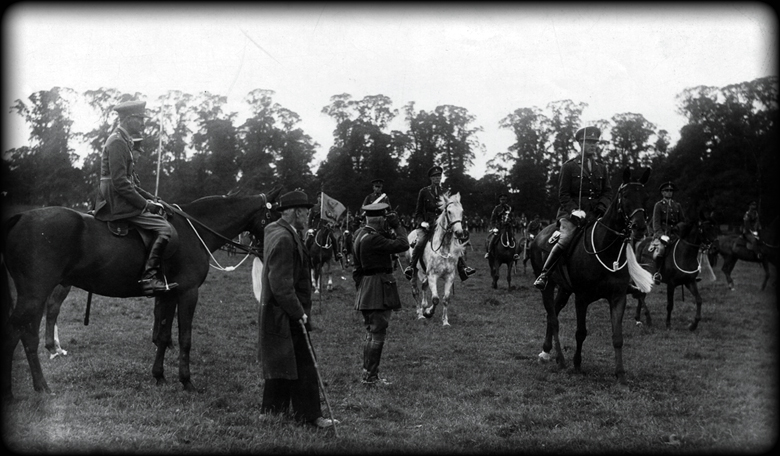
"C" Squadron marching past their standard in 1935.

D Squadron :- The crest of Major C. J.
Henry, Squadron Leader of D Squadron at the time of institution.
A dexter cubit Arm, erect, holding a sword in pale,
proper, pommel and hilt Or, issuing an amulet gules, between two
roses of the last, barbed and seeded proper.
Motto: "PER LABOREM PAX" (Peace Through Labour)
The several Squadron badges are perpetual, and will not
be changed on succession of Squadron Leaders.
** From the period of 1901-1957 there does not appear to be a
record of the Regiment having a new Standard or Guidon
officially presented. In 1958 the new amalgamated Regiment of
the Leicestershire and Derbyshire Yeomanry (PAO) are presented
with a Guidon
by Lt.Col. Sir Edward Bolitho KBE, DSO (Lord Lt. for the County
of Cornwall). 11: 30 a.m. 12th June at Penhale Camp near
Newquay, Cornwall..**
Prince Albert's Own Leicestershire
Imperial Yeomanry
1901-08
Sovereign:- Edward VII
No record of a new Standard or Guidon
The 1858 Regulations
The 1858 regulations incorporated a significant change to the
flags carried by the Cavalry Regimens. A new measure, given
Royal approval in August of that year, stipulated that in future
they were to carry only one flag, to be called Royal, or First,
Standard or Guidon. Instead of the Union badge this flag was to
bear the authorised badge, motto and honours of the Regiment,
all on a crimson sheet. The cartouches in the second and third
corners were still to bear the "Rank of the Regiment", but this
would be on a field in the colour of the Regimental facings
instead of the original crimson. By 1868 the Cavalry finials had
converted from the spear head to the Royal crest.
Prince Albert's Own Leicestershire Yeomanry Cavalry
Post 1843
x5 Standards (one per Troop):- * Presented, on the 26th
of September 1844, by Lady Georgiana Charlotte
Curzon. The presentation was made at the Leicester Race Course.
Sovereign:- Queen Victoria
Consecration:- ** The Rev. A Irvine, Chaplain to the Regiment.
"Upon these Standards, now to be committed to their trust,
we fervently implore Thy divine blessing. May they never be
unfurled but for Thy glory, and Thy people's good. May their
defender be joined together in unity of spirit, earnestly
working together with their fellow subjects, and with each
other, for the peace and safety of our native land; ever mindful
of the solemn account which they must one day give at the seat
of Christ."
* See:- The Bulletin of the Military Historical Society, Volume
51, N.203, Feb 2001, page 137.
** The Leicester Chronicle, dated 28th September 1844, The
Leicestershire Yeomanry Cavalry.
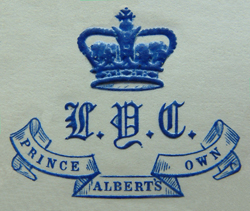
Letter head badge pre 1901.
The 1844 regulations were contained within that year’s
edition of the Queen’s regulations. They included much more
detail than previous editions, and introduced several changes.
In the first of these, the King’s Standard or Guidon became the
“Royal”, while the second became the “Regimental”.
The term “Provincial Standard”, used to denote the second
Standard by a number the Yeomanry Regiments around the time of
1794. These included the Loyal Leicestershire Volunteer Cavalry
of 1794, and the Worcestershire Yeomanry, which used the phrase
for its second Guidon, presented in 1797, and carried by the
Second Troop.
New Standards were presented to the Regiment on Thursday, 26th
of September, 1844, by *Lady
Georgiana Curzon (Leicester Chronicle 1844 : The Leicestershire
Yeomanry Cavalry).
The PAOLYC Royal Standard was discovered in an Estate dispersal sale
by Clare Auctions in October 2015 and purchased back into
Regimental custody on Saturday, 7th of November, 2015. The above
is a representation of the PAOLYC Sovereign's Standard made from
the image of the real thing. (Many thanks to Robin Stone,
Auctioneer, Clare Auctions)
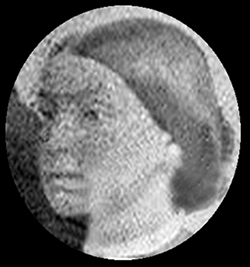
* Lady Georgiana Charlotte Curzon (1825–1906), married Henry
Somerset, 8th Duke of Beaufort. The eldest daughter of
Richard Curzon-Howe, 1st Earl Howe.
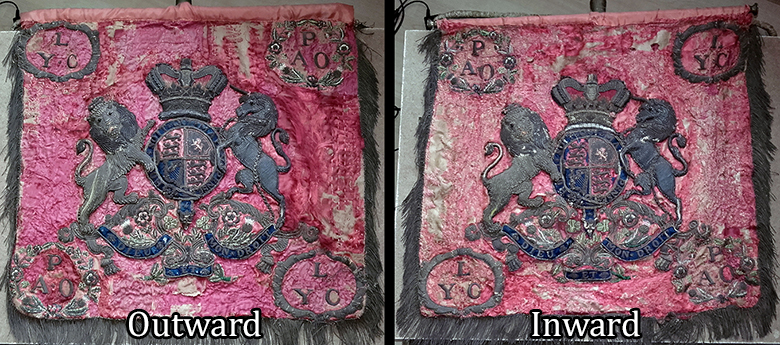
The PAOLYC Royal Standard had been taken apart and made into two
fire screen stands at some point in its history after
retirement. The LDYPAO Association is now undertaking a
restoration plan that will see the standard returned to its
proper function and preserved for the people of Leicestershire &
Rutland to enjoy as well as National visitors at the Rutland
Museum in the fullness of time.

What is thought to be have been a Drum banner is more than
probably the Regimental (Provincial) Standard. The Standard is a
blue silk (the colour of the Regiment's facings in that period) and the design is painted on, a much less costly
method than the very expensive (at the time) embroidered Royal
Standard.
The original has been cut to fit a picture frame . There would have been two sides
and the outer edge would have had gold or silver braiding.
The blue ribbon seen in the photo is probably a later addition
to cover the cut edges whilst displayed in the old picture
frame.
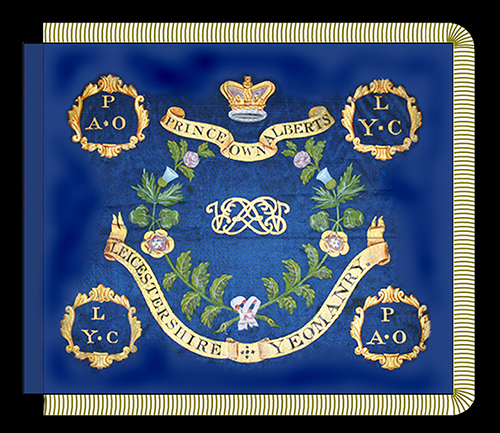
The Provincial/Regimental (second) Standard.
The Leicestershire Regiment of
Yeomanry Cavalry
also known as :- "Loyal
Leicester Volunteer Cavalry"
5th September 1803-44
Col. George Anthony Legh-Keck
Royal, Provincial and Squadron Standards
(1794 Standards used)
Sovereign:- George III to 1820 then George IV
to 1830 then William IV to 1837 then Queen Victoria
There is very little evidence of the early LYC standards, though
they were Standards and not Guidons. They are illustrated on the
so called "Loraine cup" .
The cup was given to Charles
Loraine-Smith on his retirement from the yeomanry. He was a Sporting artist and he
studied under and was friends with George Morland (painter)l.
Loraine-Smith was a keen hunt follower
and hunted with the Quorn, he lived from 1751-1835 (Aged 43 in
1794) and moved to the North of England in later life.
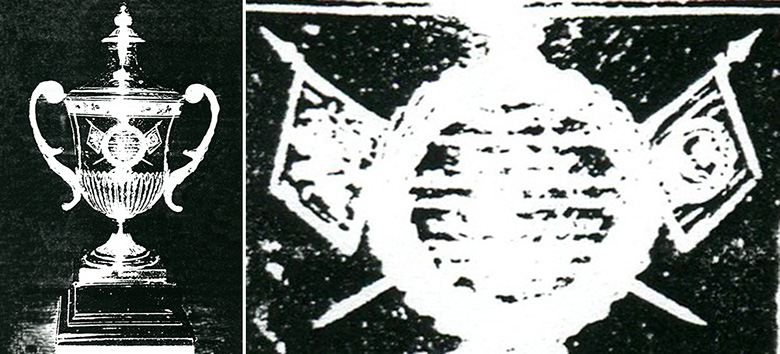
The inscription on the cup:-
This cup was presented by the Privates of the Leicester Troop of
the Leicestershire Yeomanry Cavalry to their Captain
Loraine-Smith Esq as a token of their esteem, 1802.
On the left we see the Kings Standard and it displays the Royal
Arms of George III and on the right we see the "Provincial"
Standard (made by Mary Linwood). Sadly the detail is poor as the
above image is a photocopy of a photocopy.

This picture of the LYC was painted by J Marshal, in
watercolour, depicting the inspection of the LYC on the
30th Sept' 1813. The occasion marked the 10th year of command by
Lt.Col. George Leigh-Keck. Each Squadron carries its own
standard and there is a group of three mounted men that appear
to have the regimental standard or Guidon but "cased". The
Mounted group in blue are the Regimental band. The enlarged
pictures below are of the Squadrons from left to right in
sequence.
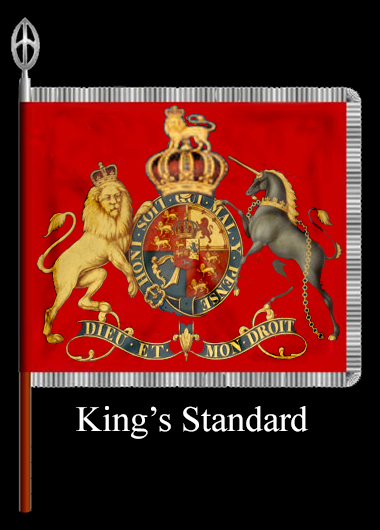
The above is a representation based on the Loraine Cup
image.
The size of the Standard would be the smaller Cavalry Size.

At the moment this is the best image we have of the provincial
Standard made by Miss Mary Linwood. The Standard
appears to be striped, on that a wreath (or possibly a garter)
and in that what may be a unique design and not necessarily
military? See the description eluding to it below.
From
La Belle Miss Linwood (Nov 1821):- “We mention it as an
extraordinary incident, highly resounding to the honour of the
fair artist, that she wrought the first banner offered to any
military association; and, in the year 1794, she presented it to
the united corps of cavalry and yeomanry of Leicestershire. The
design was original and extremely appropriate, and the whole
finished with a neatness seldom united with such strength and
force of design."
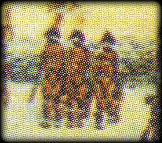
A "cased" Standard, this is probably the
Provincial Standard (made by Miss Mary Linwood in 1794). The
Standard would be rolled up and a leather tube case with a brass
top would be used to cover the standard for protection and only
brought out on special occasion.

"The King's Standard"
carried by the 1st Troop/Squadron.

2nd Troop/Squadron.
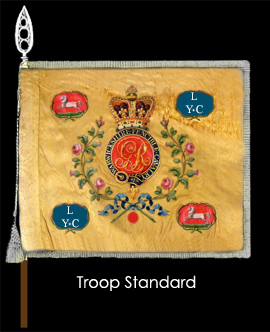
The above image is made from a period "Troop" Standard
and numbered
by Troop/Squadron just below the central Royal badge on the
small red circle. The addition of "LYC" on the colour of the facings
in the cartouches. This image is just a
"best" guess at what a
Troop Standard might have looked like for the Regiment.

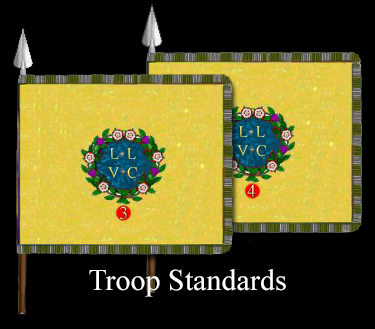
A representation of the 3rd & 4th Troop standards as
depicted in the watercolour. The first (King's/Royal) and second
(Provincial/Regimental) standards were not numbered.

3rd Troop/Squadron.
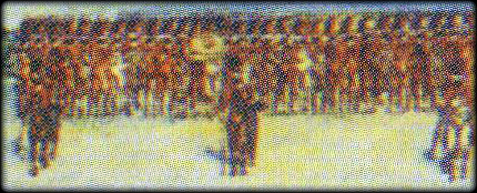
4th Troop/Squadron.
The Loyal Leicestershire Volunteer
Cavalry
Date:- 9th May 1794 to 1803
Col. Sir William Skeffington
6 Troops
Sovereign:- George III
Royal Standard:- 29th August 1794, donated by *Lady
Charlotte Curzon, daughter of Lord Howe.
Provincial Banner:- 29th August 1794,
presented by Lady Skeffington
(attended by Mr Hungerford & the Mayor of Leicester) and
made by Miss Mary Linwood. Miss Linwood was a local
celebrity, noted not only in Leicestershire but also
nationally for her artistic needlework.
Consecration of the Standards :-
Chaplain, The Rev T Gresley B A
(According to the Leicester Chronicle, dated 28th September
1844, the Rev. T Robinson, vicar of St. Mary's, consecrated the
first set of standards in 1794).
The Gentleman's magazine Vol.66 P.II 1796
Country News Oct 7th 1796
On Presenting the Royal Standard
On this memorable day the Leicestershire Volunteer Cavalry
received their standards in form the appearance of 300
respectable neighbours, voluntarily standing forth in defence of
their Country, at tended by the civil power of the county and
town, as if uniting themselves in support of each other;
honoured by the presence and respect of the neighbouring
nobility and gentry surrounded by numerous concourse of" their
fellow countrymen and crowned with the approbation of the
principal beauties in Leicestershire, who seemed to look up to
them as the "manly hearts who guard the fair !" was ceremony as
interesting and splendid as the occasion was momentous and
glorious. Early in the morning an officer's guard, under the
command of Capt.-Lieut. Burnaby, mounted guard at Head Quarters,
and attended the per son of the Colonel (Sir William Skeffington,
Bart.) throughout the day. At eleven o'clock the troops
assembled, from their different alarm posts, and formed hollow
square in the Market Place after which, an officer's guard from
the Colonel's troop, conducted Miss Linwood, so justly
celebrated for her needle work, with the truly elegant banner
she had wrought as patriotic donation to the corps, attended by
Mr. Hungerford (who represented the Lord Lieutenant of the
county) to head quarters, where there was splendid assemblage of
Ladies. The Leicester Troop, under the command of Capt. Heyrick,
then conducted the Mayor and Corporation from the Guild Hall, in
their formalities, to the Market Place, where they were received
by the Colonel, and saluted as they passed the line. The Royal
Banner, which was extremely elegant, and the donation of Lady
Charlotte Curzon, daughter of the gallant Earl Howe was then
displayed to the troops, escorted by the High Sheriff and Earl
Moira; at the same time Lady Skeffington, attended by Mr.
Hungerford and the Mayor of Leicester, displayed the Provincial
Banner. The presenting Ladies, attended by train of Ladies and
Gentlemen, en uniforme, after passing in front of the line,
presented the banners to the Colonel, who delivered them to the
senior cornets, accompanied by manly and appro priate speech. On
the standards being received, they were saluted by the troops.
The colonel then, with animation and dignity highly becoming his
character and rank, on presenting the Royal standard, thus ad
dressed the corps
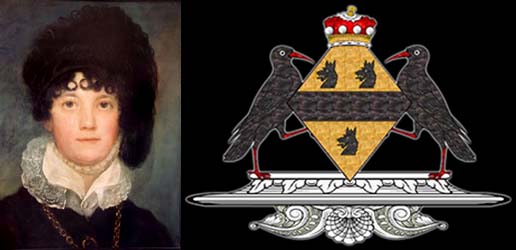
* Lady Sophia Charlotte Curzon nee Howe, 2nd Baroness Howe
(1762–1835)
The Colonel :-
"Gentlemen,
I have the honour to present this Royal Standard to the Corps,
being the gift of Lady Charlotte Curzon, as a testimony of her
loyalty to her Sovereign, her zeal for the glorious cause we are
engaged in, and her singular regard for the honour and welfare
of the Loyal Corps of Leicestershire Volunteer Cavalry.
Under the influence of the donative of the daughter is the
victorious Earl Howe, I am confident that, whenever occasion
offers, it will incite you to valorous deed; to the honour of
the donor, and the esteem of your country; remembering that it
is to be valiantly defended and never yielded but with life.
Long live the King!"
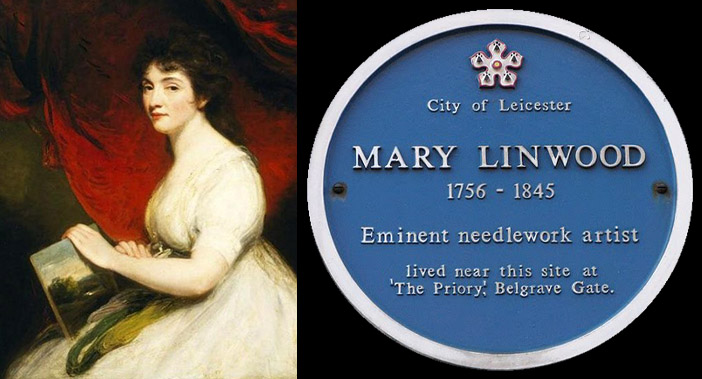
Miss Mary Linwood by Hoppner and her blue plaque in Leicester.
See also
At a guess, as we don't have a description or image of the
Provincial Standard today made by Mary Linwood, it can be
thought that this was no ordinary work. We can only hope that
the Standard has survived in a private collection (or
Museum/Gallery vault) and that one day we might see it again.
Its not something that would have been left to rot in a church
or cathedral we hope.
On Presenting the Provincial Standard
The Colonel :-
"Gentlemen,
Impressed with an unalterable loyalty for her Sovereign and
attachment to her country, Lady Skeffington expresses a heart
felt satisfaction in the opportunity of this public declaration
of her sentiments. The presentation of the provincial Standard
she esteems not only an appropriate duty, but also as an honour
which she ever must remember with sensations as animating as the
memorable cause we so gloriously are engaged in. She warmly
participates in the apportion excited by Miss Linwood, to whose
ingenuity and loyalty we are indebted for a Standard, which ***,
in point of work, must be eminently conspicuous. Lady
Skeffington, maintaining a steadfast esteem for the spirited and
gallant Corps of Leicestershire cavalry, ardently hopes an
unvarying prosperity may happily distinguish our patriotic
regiment, for whose welfare she *** must retain the most anxious
regard. Sincerely wishing each individual Yeoman every success
which valour must deserve, she expects you to remember that this
standard, the insignia of honour, like honour, should be yielded
but with life."
A Standard was also
given to the King and was taken back to Windsor Castle? This
has not been confirmed.
Rutland Yeomanry Cavalry
25th April 1794 to 1828
Standards :- A delayed presentation, 29th Oct 1795,
because of the death (25th July 1795) of the donor John Heathcote Senior.
He was the third son of Sir John Heathcote, 2nd Baronet
(1689-1759).
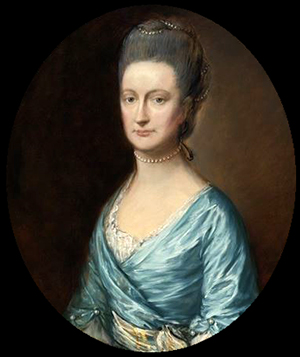
A portrait of the Right Honourable Lady Mary Fludyer (1773-1855)
of Ayston in Rutland by Thomas Gainsborough. Daughter of John
Fane, 9th Earl of Westmorland and Susan Fane,
Countess of Westmorland. Wife of George Fludyer.
Country News,
Uppingham 29th Oct 1795
(Taken from "Gentleman's Magazine" November 1795. Page
959)
This morning the Yeomen, who first associated in defence of
their Country, assembled at Uppingham, to receive the standards
intended for them by the late worthy representative of the
County, John Heathcote Esq. the lamented death of that truly
excellent man accounts for the delay of placing their standards
in the possession of the "first" body of British Volunteer
Yeomanry. The Troops having formed into two Squadrons , upon a
signal from the Earl of Winchelsea, their Colonel, Francis
Cheselden, and Robert Tomblyn, Esquires, the two Cornets,
advanced on horseback a few yards in front of the line, when,
having quitted their horses, they were severally invested with
the elegant insignia of their rank by Lady Mary Fludyer and Miss
Fielding. The colours were then presented , by Lady Lydia Heathcote,
to the Earl of Winchelsea, who delivered them to the two
Cornets. On perceiving the standards in the hands of the
Cornets, the band played the tune of "God Save the King". The
words formed a general prayer; after which the colours were
consecrated by the Rev. Mr Blythe, Chaplian to the Corps,
conducted by a guard, bore the colours to their places in the
line, the band continued to play,
"Britons strike home".
The Earl of Wichelsea, in a manly, nervous, and expressive
address, then congratulated the Corps on the testimony which had
been that day paid their merits. On this subject, the noble
speaker declared himself in competent to offer sufficient praise
to the Corps he had the honour to command. His Lordship adverted
to the perfect tranquillity of the Country, which, he reminded
them, was owing to the spirit and exertion of the "leading Corps
of British Yeomanry". The obligations expressed by the
neighbouring counties to the Yeomanry of Rutland, for a place
and institution so beneficial to the Kingdom, were noticed in
the language of that true modesty which neither disclaims the
pleasure of praise for good example, nor conceals the thanks of
those who are benefited by it. Lord Winchelsea was firm,
generous and delicate. he was himself the admirer of the beloved
Sovereign, at the head of affectionate and loyal subjects.
The alacrity of the Yeomanry to suppress the first appearance if
not received a just acknowledgement; and his Lordship concluded
his speech by remarking, that the exemplary behaviour and
uniform good conduct of the Rutland Yeomanry Cavalry gave their
fellow subjects an unequivocal proof of their resolution
to defend them, and their Colonel the firmest confidence in
their future fortitude. When his Lordship had concluded his
address, the Troops testified their entire concurrence with his
sentiments by three hearty huzzars. The whole body, attended by
a numerous host of spectators, whom one soul only seemed to
animate, proceeded in military order from the field where the
colours had been consecrated, to the Market place; the colours
received from the Cornets by - Woods Esq, were there lodged.
Divine service succeeded, when it might have become a question
whether the men who had been foremost to service their
bravery were more exemplary for courage than for piety. The
sermon addressed to the Corps by their Chaplain was unanimously
ordered to be printed.
After divine service, the Troops had the happiness of meeting
their friends in the free school indulged by the Rev. Mr Butt
and which convenient by accommodated the whole party. There was
plentiful supply of venison and an excellent dinner was served
in a way which gained the thanks of the company to the three
Yeoman publicans, the landlords of the Falcon, Unicorn and Eight
Bells Inns, each of whom was emulous to gratify the Troops he
had the honour to serve. The Other emulation of the day was that
loyalty and kindness. It was a feast of brethren, and the
meeting was one continued scene of affectionate cordiality.
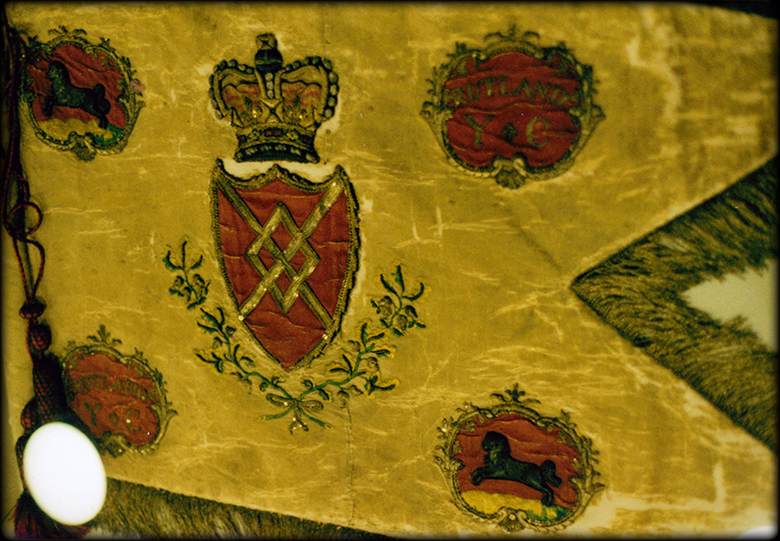
Rutland Yeomanry Cavalry (Provincial Banner) Guidon was Buff silk embroidered with Gules, a frette
Or. The "Harrington Knot" is the badge of Rutland.
"The Gentleman's Magazine" Vol.65. P II, 1795
Page 930. par.209
An extract from:-
"Thoughts on the Provincial Corps raised and now raising in
support of the British constitution at this awful period" By a
Private in the Leicestershire.
" The Rutlandshire Yeomanry, who, to their honour, very early
stepped forward in the cause of their King and Country, are
cloaked in grey, the colour of us "old" established regiment
under the crown."

The King's Standard of the Rutland Yeomanry Cavalry held
at the Rutland Museum. The Coat of arms emblazoned upon the
banner is that of George III. The field colour of the banner is
a very faded red silk.
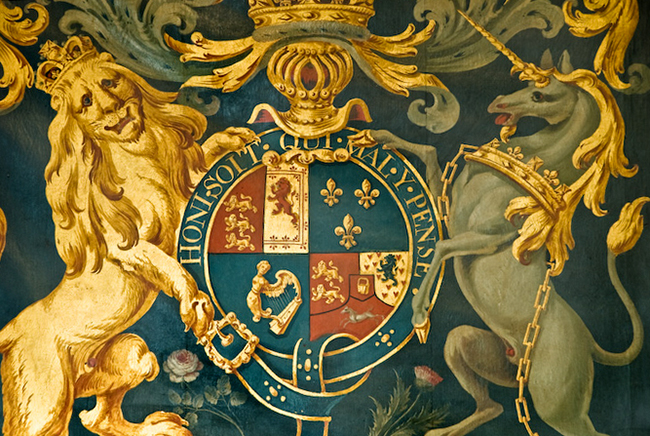
|
|
|
|
|